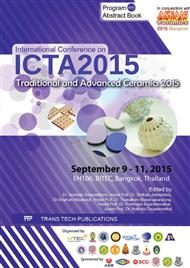[1]
D.R. Richerson, Modern Ceramic Engineering, Marcel Dekker, Inc., NY, 1992, 294.
Google Scholar
[2]
D.J. Crail, R.S. Tebble, Ferromagnetism and Ferromagnetic Domains, vol. IV, in: E.P. Wolfarth (Ed. ), JohnWiley & Sons, Inc., New York, 1965, p.99.
Google Scholar
[3]
Information on http: /www. aacg. bham. ac. uk/magnetic materials.
Google Scholar
[4]
D. Lisijak, M. Drofenik, The mechanism of the low-temperature formation of barium hexaferrite, J. Eur. Ceram. Soc. 27 (2007) 4515-4500.
Google Scholar
[5]
H Kojimi, Ferromagnetic Materials, vol. 3, in: E.P. Wohlfarth (Ed. ), North Holland, Amsterdam, 1982, p.305.
Google Scholar
[6]
H.J. Zhang, X. Yao, L.Y. Zhang, The preparation and microwave properties of Ba2ZnxCo2-xFe28O46 hexaferrites, J. Magn. Magn. Mater. 241 (2002) 441-446.
DOI: 10.1016/s0304-8853(01)00447-4
Google Scholar
[7]
M.W. Pieper, F. Kools, A. Morel, NMR characterization of Co sites in La+Co-doped Sr hexaferrites with enhanced magnetic anisotropy, Phys. Rev. B 65 (2002) 184397.
DOI: 10.1103/physrevb.65.184402
Google Scholar
[8]
Q.Y. Feng, L. Jen, Microwave properties of ZnTi- substituted M-type barium hexaferrites, IEEE Trans. Magn. 38 (2002) 1391-1394.
DOI: 10.1109/20.996032
Google Scholar
[9]
P. Wartewig, M.K. Krause, P. Esquinazi, S. Rosler, R. Sonntag, Magnetic properties of Zn- and Ti-substituted barium hexaferrite, J. Magn. Magn. Mater. 192 (1999) 83-99.
DOI: 10.1016/s0304-8853(98)00382-5
Google Scholar
[10]
V. Babu, P. Padaikathan, Structure and hard magnetic properties of barium hexaferrite with and without La2O3 prepared by ball milling, J. Magn. Magn. Mater. 241 (2002) 85-88.
DOI: 10.1016/s0304-8853(01)00811-3
Google Scholar
[11]
P. Shi, H. How, X. Zuo, S.D. Yoon, S.A. Oliver, C. Vittoria, MMIC circulators using hexaferrites, IEEE Trans. Magn. 37 (2001) 2389-2391.
DOI: 10.1109/20.951181
Google Scholar
[12]
M. Nejezchleba, Z. Simsa, K. Zaveta, Magnetic Structure of Hexagonal Ferrites Studied by Mössbauer Spectroscopy, J. Phys. IV 7 (1997) 345.
DOI: 10.1051/jp4:19971139
Google Scholar
[13]
M. Pal, P. Brahma, B.R. Chakraborty, D. Chakravorty, DC conductivity in barium hexaferrites doped with bismuth oxide, Jpn. J. Appl. Phys. 1 (1997) 2163-2166.
DOI: 10.1143/jjap.36.2163
Google Scholar
[14]
A.S. Kamzin, V.L. Rozembaum, Mössbauer studies of the surface and bulk magnetic structure of scandium-substituted Ba–M-type hexaferrites, Phys. Solid State 41 (1999) 433-439.
DOI: 10.1134/1.1130797
Google Scholar
[15]
C. Dube, S. Kashyap, D. Pandya, D. Dube, Dieletric and magnetic properties of Zn-Ti substituted M-type barium hexaferrite, Physics Status Solidi A. 206 (2009) 2627-2631.
DOI: 10.1002/pssa.200925104
Google Scholar
[16]
N. Yang, H. Jia, J. Pang, Formation and magnetic properties of nanosized PbFe12O19particles synthesized by citrate precursor technique, J. Alloy Compd. 438 (2007) 263-267.
DOI: 10.1016/j.jallcom.2006.08.037
Google Scholar
[17]
V.V. Soman, V.M. Nanoti, D.K. KulKarni, V.V. Soman, Effect of substitution of Zn-Ti on Magnetic and Dielectric Properties of BaFe12O19, Physics Procedia. 54 (2014) 30-37.
DOI: 10.1016/j.phpro.2014.10.033
Google Scholar
[18]
M.H. Shams, A.S.H. Rozatian, M.H. Yousefi, J. Valíček, V. Šepelák, Effect of Mg2+ and Ti4+ dopants on the structural, magnetic and high-frequency ferromagnetic properties of barium hexaferrite, J. Magn. Magn. Mater. 399 (2016) 10-18.
DOI: 10.1016/j.jmmm.2015.08.099
Google Scholar
[19]
S. Kanagesan, S. Jesurani, R. Velmurugan, S. Prabu, T. Kalaivani, Structural and magnetic properties of conventional and microwave treated Ni-Zr doped barium strontium hexaferrite, Mater. Res. Bull. 47 (2012) 188-192.
DOI: 10.1016/j.materresbull.2011.11.053
Google Scholar


